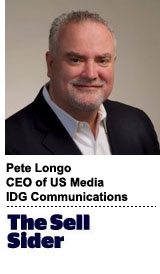 “The Sell Sider” is a column written by the sell side of the digital media community.
“The Sell Sider” is a column written by the sell side of the digital media community.
Today’s column is written by Pete Longo, CEO of US Media at IDG Communications.
It’s a data-driven world, and digital ad buyers still rely on the legacy notion that “scale” is necessary to harness as many eyeballs and as much data as possible. It’s a “bigger must be better” mentality – but it’s a trap.
The market needs to reset its expectations about why audience size matters and realize that we now have a new opportunity with data-driven solutions to offer better targeting and more specificity against the most highly qualified audiences.
Data, Data, Everywhere
Data has always been the marketer’s holy grail, and with good reason. If leveraged correctly, it can add significant value and efficiency to marketers’ ad campaigns and bottom lines. With upward of 7 billion potential cookies available to buyers in data marketplaces, such as BlueKai, or via demand-side platforms, this may sound great to marketers simply chasing scale. But ultimately, digesting and properly analyzing massive data pools and extracting useful value from them can be difficult.
In the end, there can be diminishing returns on digital ad investments when marketers simply chase more eyeballs and more data – more than they necessarily need because applying data on every nuance of a vast audience’s online behaviors doesn’t always translate to improved KPIs.
Bigger Isn’t Always Better
We also now know with great certainty that the more scale an advertiser seeks in the Wild West of the internet, the more ad fraud and fake impressions can seep in. That’s one reason why marketers are flocking to premium publishers.
The digital advertising ecosystem has fixated on volume for far too long, and while many publishers would be happy to keep pushing that notion to appeal to advertisers and lock in larger campaign opportunities, it’s far from a strategic approach. As partners, publishers need to be consultative with their customers and help educate them on how to efficiently spend toward their desired marketing objectives.
Every day, B2B publishers get asked questions by marketers such as: “You can deliver 33,000 unique users? Great. But can’t we get even more?” But what if their desired audience is CIOs in the United States – a group of about 41,000 unique users in total? Shouldn’t reaching more than 80% of that audience be sufficient and deliver results, particularly if the campaign is meticulously developed and planned?
What if a marketer’s desired target audience is “custom home builders?” That’s very specific as well, and you’re not likely to get endless possibilities. But you probably can find B2B publishers that, through their data, can serve up a meaningful slice of that audience.
Or, let’s say marketers know there will be 4 million widgets sold in the US next month, and their publisher partner can use its first-party data to help them target 3 million of those potential buyers. That’s 75% of the addressable market. So when the marketer suggests adding in 10 million more “unbranded” widget intender cookies from an unnamed data provider with unknown collection methodology to make sure they’ve covered the entire market, the publisher needs to have that conversation around scale, specificity and efficiency.
B2B And B2C
Then there’s the B2C sphere. Let’s say a food magazine is offering up dessert enthusiasts, and it can narrow that universe to brownie lovers as well. It may even be able to segment white chocolate brownie lovers or people who want a gluten-free brownie. Just as in the B2B world, the ability to narrow the segmentation is what’s truly valuable when selling a certain product.
In the B2B sphere, B2B publications often have a detailed and discerning user registration process to gather firmographic information beyond name and email address, such as a job title, function and sometimes company size and revenues. That’s incredibly valuable and specific data about a highly targeted and attractive audience.
Overall, no premium publisher wants its marketer partners to waste money. Mutual success is the goal, and each publisher needs to communicate the most efficient way to position its products. It’s very simple: As you increase audience specificity and quality, scale by definition has to decline.
Follow IDG (@IDGWorld) and AdExchanger (@adexchanger) on Twitter.












